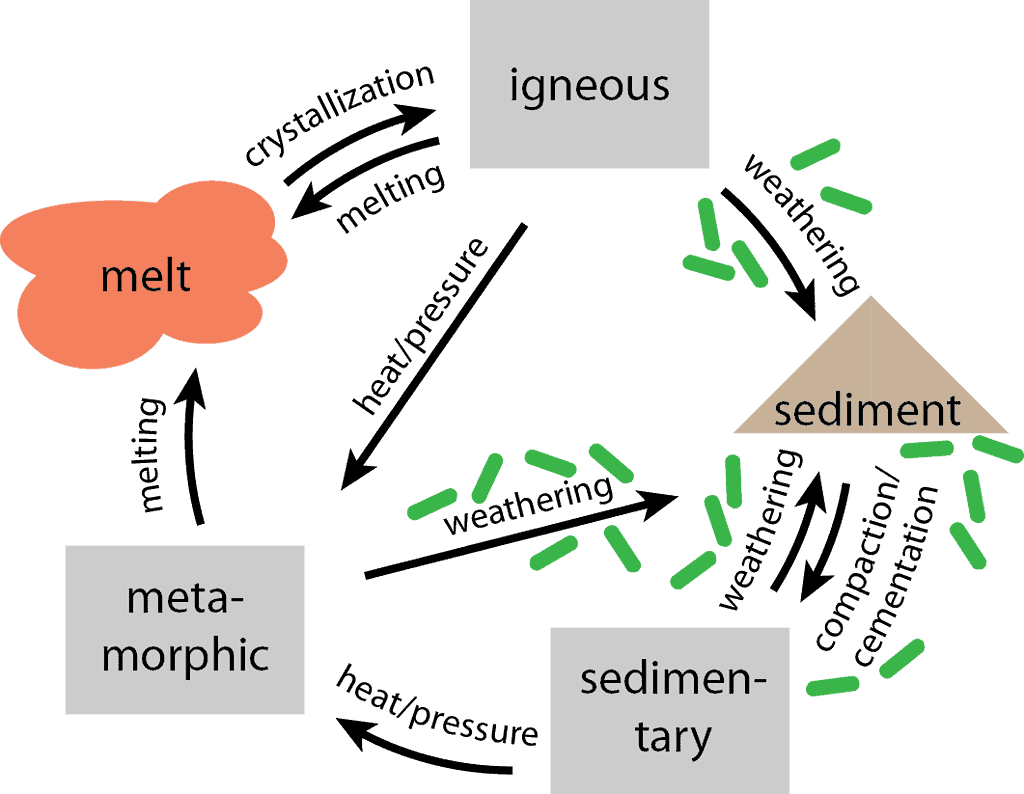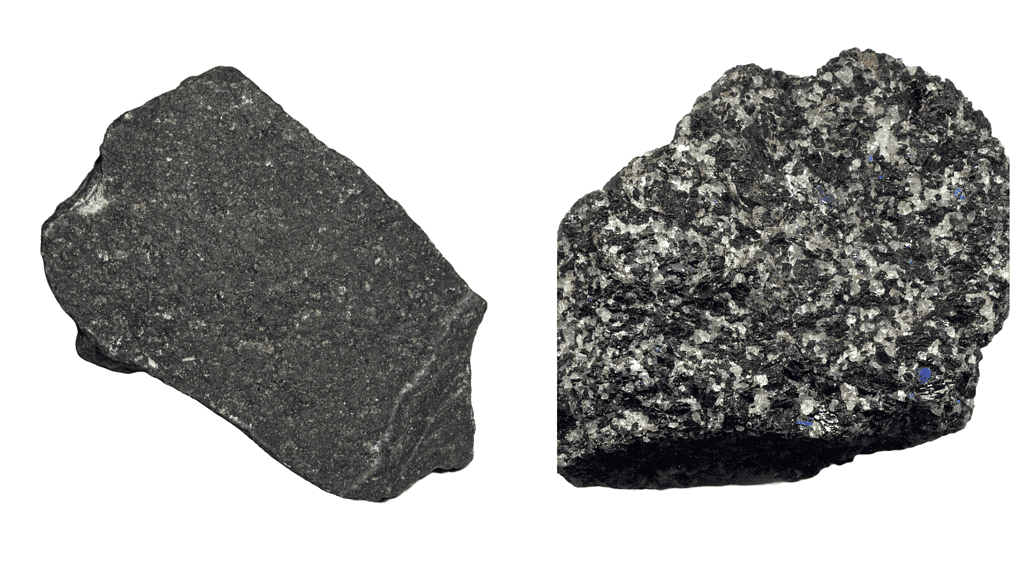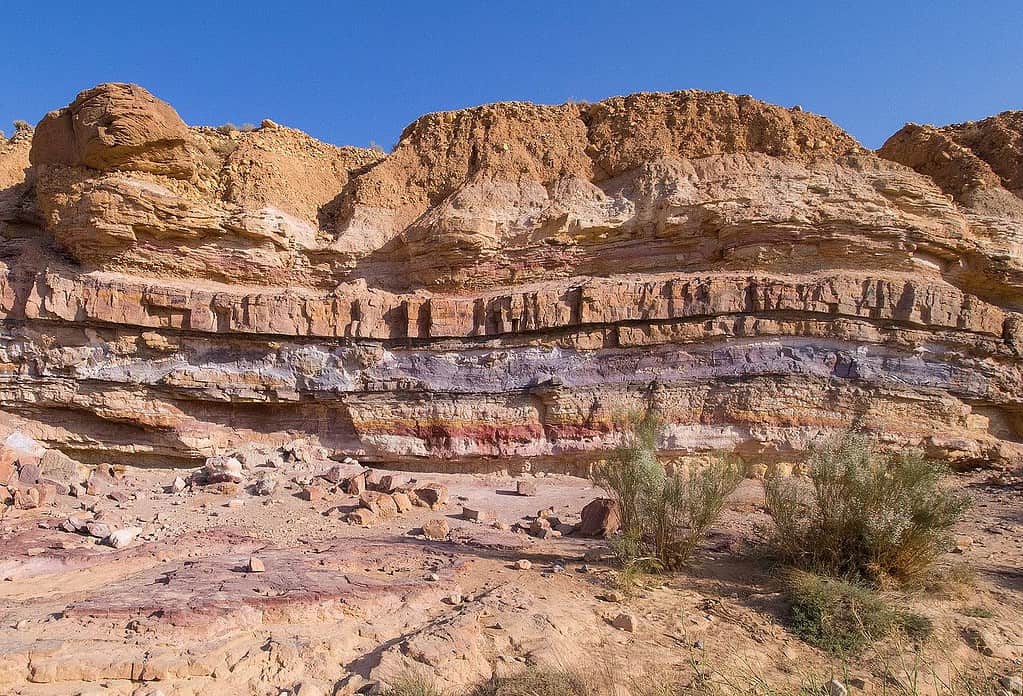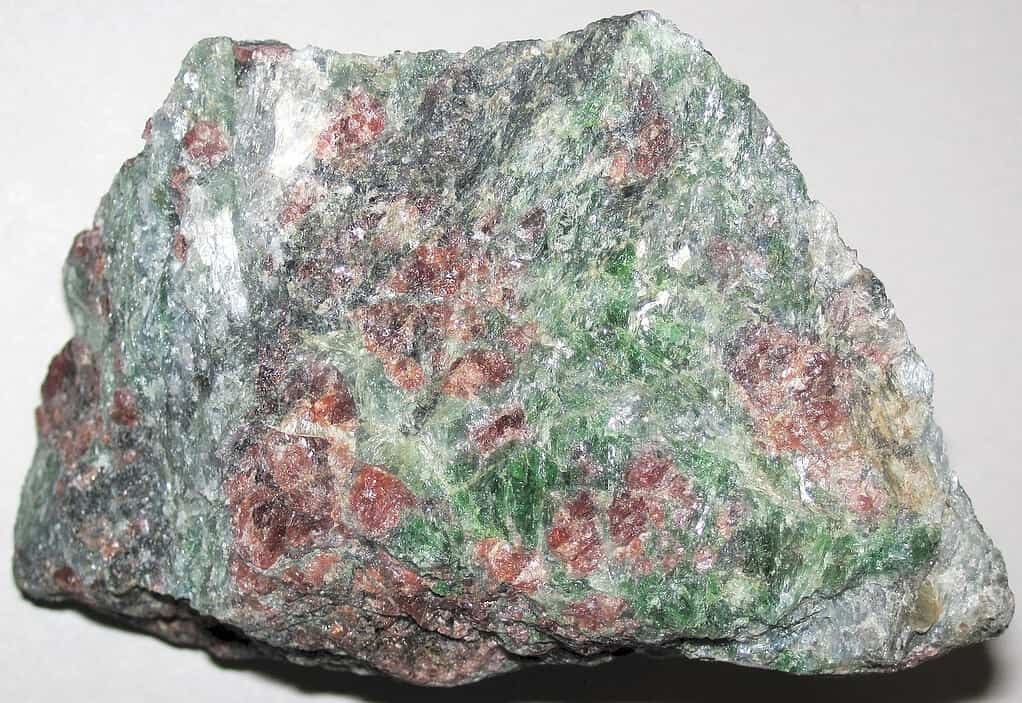
Rocks, the building blocks of Earth’s crust, tell a story of change that spans millions of years. Rocks change — they change their shape, texture, and chemistry. The formation and metamorphosis of rocks is a fundamental aspect of geology and a complex dance of elements. Among the myriad factors influencing this process, temperature clearly stands out.
From the fiery depths of volcanic magma to the cool, sediment-laden waters of ancient oceans, temperature’s influence is as varied as it is significant. Let’s see how.
The rock cycle and temperature
At the heart of rock formation lies the rock cycle, an ongoing series of processes that transform rocks from one type to another.
There are three main types of rocks, and these shape the rock cycle: igneous, sedimentary, and metamorphic. To understand how temperature affects the rock cycle, we need to take a quick glance at these types of rocks.
Igneous rocks form from the solidification of molten magma or lava. The temperature at which this magma cools determines the texture and composition of the resulting rock. Granite and basalt are classic examples, each born from different cooling environments.
Sedimentary rocks, on the other hand, arise from the accumulation and compression of mineral particles, organic matter, or both. Temperature influences sedimentation rates and the chemical processes that bind these materials into rock. Limestone and shale emerge from such processes, carrying imprints of the temperatures at which they formed.
Metamorphic rocks, the third category, are born from existing rocks that transform. This metamorphosis, driven by intense heat and pressure, alters the mineral composition and structure of the rock. Gneiss and schist are quintessential metamorphic rocks, each telling a tale of transformation.
Now, let’s see how temperature affects rock formation and the transformation of rocks from one type to another.

From Magma to Stone: Losing Heat
Igneous rocks are born from the cooling of magma. They are a prime example of how temperature affects rocks.
Deep within the Earth, in its molten heart, magma forms at temperatures ranging from 700°C to 1300°C. For igneous rocks to form, the magma needs to cool down, which typically happens when the magma rises through the surface becoming lava.
As magma rises towards the surface, the cooling journey begins. The rate of cooling plays a crucial role in determining the rock’s characteristics. Fast cooling, often seen near or at the Earth’s surface, leads to the formation of fine-grained rocks like basalt. These rocks have small, almost invisible crystals due to the rapid solidification of minerals.
In contrast, slow cooling magma, typically found in deeper underground chambers, gives birth to coarse-grained rocks like granite. Here, minerals have more time to grow larger crystals, creating the distinct granular appearance of granite. The temperature at which different minerals crystallize, known as the Bowen’s reaction series, further influences the rock’s final composition. For instance, the olivine mineral crystallizes at higher temperatures, while quartz (another mineral) forms at lower temperatures.

Furthermore, the composition of magma itself is temperature-dependent. High-temperature magmas tend to be more fluid and less viscous, often leading to explosive volcanic eruptions that form rocks like pumice and scoria. Lower-temperature magmas, richer in silica, are more viscous and form intrusive rocks like granite.
In summary, the formation of igneous rocks is a often story of temperature dynamics. From the depths where they originate to the surface where they cool, temperature dictates their texture, composition, and even the way they emerge onto the Earth’s surface.
Temperature’s Imprint on Sedimentary Rocks
Sedimentary rocks are the most common type of rock on the planet’s surface. Unlike the fiery birth of igneous rocks, sedimentary rocks form at much cooler temperatures, typically at the Earth’s surface where conditions are milder. Temperature impacts these rocks in two main stages: sedimentation and lithification.
During sedimentation, temperature influences the weathering and erosion of existing rocks, which breaks them down into smaller particles. High temperatures accelerate chemical weathering, leading to more dissolved minerals in water. These minerals, when precipitated in warmer waters, contribute to the formation of sedimentary rocks like limestone. In cooler climates, physical weathering dominates, resulting in coarser materials that form rocks like sandstone.

Lithification, the process of turning sediment into rock, is also temperature-sensitive. Higher temperatures can speed up the chemical reactions that cement sediments together. For instance, in warmer, shallow marine environments, calcium carbonate precipitates more readily, forming rocks like limestone and dolomite. In cooler temperatures, organic material decomposes slower, leading to the formation of coal from plant debris.
Additionally, temperature fluctuations in depositional environments can lead to distinct layering in sedimentary rocks. Varied temperatures across seasons or geological epochs result in different layers of sediment, each capturing a snapshot of the climate at the time of deposition.
In summary, temperature plays a nuanced but critical role in the formation of sedimentary rocks. It influences not just the type of sediments formed but also how they are cemented.
Temperature and metamorphic rocks: from one rock type to another
Metamorphic rocks are geology’s chameleons and they’re sculpted by the profound interplay of heat and pressure deep within the Earth. Temperature, in particular, is a master artist in this process, exerting a transformative influence on pre-existing rocks, whether they be igneous, sedimentary, or even older metamorphic types — all of them can become new metamorphic rocks under the influence of temperature and pressure.
The role of temperature in metamorphic rock formation is twofold: it facilitates the recrystallization of minerals and promotes chemical reactions. As temperatures rise, minerals within the rock start to become unstable and rearrange themselves into new structures, better suited to high temperature conditions. This recrystallization process, often occurring without the rock melting, leads to a complete overhaul of the rock’s texture and mineral composition.
For example, limestone, when subjected to high temperatures, transforms into marble. This metamorphosis involves the recrystallization of calcite, the main mineral in limestone, into larger, interlocking calcite crystals characteristic of marble. Similarly, shale under high temperatures and pressures morphs into slate, and then with further temperature increase, into schist.

The relationship between temperature and pressure is also crucial in metamorphic processes. While temperature facilitates the recrystallization and chemical reactions, pressure aligns the minerals in a particular direction, giving metamorphic rocks like schist and gneiss their distinctive foliated (layered) appearance.
Moreover, the range of temperatures in metamorphic processes is vast, generally between 200°C and 800°C. This wide spectrum allows for a variety of metamorphic rocks to form, each reflective of the specific temperature and pressure conditions they endured. The resulting metamorphic rocks are as diverse as their formation conditions, from the shimmering planes of slate to the intricate bands of gneiss.
In essence, temperature is a crucial element in metamorphic rock formation, driving the changes that transform mundane rocks into remarkable geological wonders.
Temperature always has a role to play in geology
In this exploration of temperature’s role in forming rocks, we’ve uncovered an uqiquitous architect of Earth’s crust. From the fiery depths where igneous rocks are born to the surface processes shaping sedimentary and metamorphic rocks, temperature is a constant, influential force. It’s a factor that not only determines the type of rock formed but also imprints each stone with a unique geological signature.


